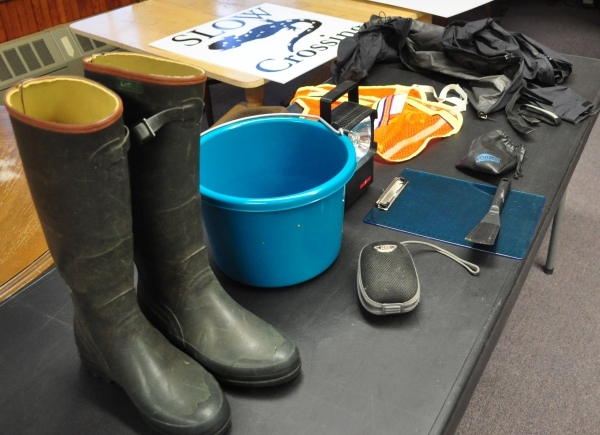DUMMERSTON — “Any Vermont child has seen these, or any curious one anyway,” Patti Smith said, pointing to a picture of one salamander at Thursday night's presentation on spring salamander crossings at the Learning Collaborative in Dummerston.
“A good, curious, log-turning kid will have seen them.”
And she's right, if the nods and satisfied “hmms” of three or four self-identified born-and-raised Vermonters is any evidence.
In part because of thin attendance, which allowed for everyone in the room to introduce themselves, and in part because for the first 10 minutes prerecorded sounds of wood frogs on spring evenings playing from Smith's laptop chirped in the background, the presentation was intimate and warm, a little magical even.
Smith is an educator at the Bonnyvale Environmental Education Center (BEEC), and is well practiced in harnessing the magic of the natural world and conveying it to a roomful of people. She's concise and lively and asks frequent questions of the audience.
One gets the impression that, for Smith, every moment of the year is cherished for its own distinctive ecological offering. Before the meeting started one attendee, upon hearing the recorded wood frogs singing, mentioned how grateful she'd be to hear those noises in real time when it got warmer, to which Smith said, sincerely, “I'm in no rush myself...I haven't had enough winter.”
While she may have been the only person in the room, and perhaps in the county, to not want a little fast-forward to warmer days, this did not dampen her enthusiasm in presenting on our area's upcoming ecological event: salamander crossings.
For most Vermonters, salamander crossings are a familiar part of each spring, but for the uninitiated, here's a crash course.
Each spring, typically on the first rainy and warm night in late March or early April, salamanders and other amphibians emerge from their subterranean winter homes and move to vernal pools to breed. This migration often forces them to cross over roads to access their breeding sites, and in their slow crossing, puts them at risk of being hit by cars.
Groups of volunteers go out on these nights to slow traffic and cross, by hand, amphibians that might otherwise be hit.
In a thoughtfully compiled presentation of photo, video and sound, Smith made fresh the usual salamander-brigade information.
The stars of these crossings are the spotted salamanders, about eight inches long with bright yellow spots, with Jefferson salamanders, the occasional blue spotted salamander, wood frogs and spring peepers filling supporting roles.
Thursday nights in Dummerston do not usually claim any similarities to Brooklyn-based performance art pieces, but the presentation included everything from wood frog soundscapes, a call to arms for reflective vest wearers, an amphibian identification pop quiz, and an informational video starring an anthropomorphized spotted salamander.
Dummerstonians marked a small moment of pride when Smith told us that ours is one of the only towns in the state where the elusive Jefferson salamander is seen regularly.
While it is charming to imagine salamander crossings happening en masse, on the same night, at the same moment in every town in the state, Smith reminded us that crossings are a little more fickle; a big crossing night in Vernon might occur three weeks before the first big night in Dummerston.
Those interested in crossing brigades can sign up for email alerts on the BEEC website to best ensure they get the right night for their area.
But is our participation in the crossing brigades necessary? A study which Smith shared in her presentation indicated that if a salamander population suffers a mortality rate of more than 20 percent, the overall population is likely to be gone within 20 years.
Although the precise effect cars have on salamander mortality has not been found, Smith reminded us that especially if you live in a heavily trafficked area, it can make a huge difference for the survival of these beautiful, rarely seen creatures. For those of who live in quieter areas, it can only help. Moreover, this is an opportunity to be involved in and a steward of your local ecosystem.
As each person gave their name and reason for attending, a theme emerged; almost everyone said that they had done crossings as a kid or with their kids, remembered it fondly, and wanted to do it again.
Said one, “It's a tradition. I'm not sure how much effect it has, but it really has become a seasonal tradition” - ۥwhich gets at the true character of these crossing brigades.
While many of us have heard VPR programs and read articles tasking us with participating in these brigades, reminding us of their importance - there is another way entirely of thinking of it.
As Smith hinted at the beginning of her presentation, salamander crossing brigades indulge the curious kid in us all. When most of us are wishing for the rainy gloominess of early April to end, crossings can be a celebration of this specific moment in spring - and while, perhaps not vital, fun.
